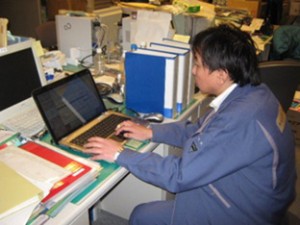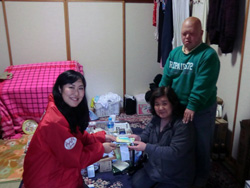 When the Association for Aid and Relief (AAR) received a phone call about three families who have children with disabilities and are living in a shelter in Ishinomaki (Miyagi Prefecture) that is running low on supplies, they quickly sprang into action, bringing food, bedding, and everyday items like nail clippers and Q-tips. The families all lost their homes in the disaster and after staying in an evacuation center at first, have been staying recently at a rehabilitation facility for people with intellectual disabilities. The trauma of this disaster has been particularly difficult for these families to cope with. For example, one mother is caring for her 21-year-old son, Kazuya, who has severe Down Syndrome. When they moved into the shelter, the stress was so severe that he refused to speak and has only recently been talking again. When the AAR team member visited, he was able to say a few words about their home being destroyed, saying, “Bye-bye house.” Because the mother needs to constantly care for her son, it is difficult for her to leave the shelter. Another 69-year-old mother who is caring for her 39-year-old daughter, also severely disabled, echoed that difficulty. At the previous shelter, her daughter would raise her voice in the middle of the night, which of course disturbed the other evacuees, but there was nothing her mother could do. Their current location is better in that sense, but they do not know how long they will be able to stay.
When the Association for Aid and Relief (AAR) received a phone call about three families who have children with disabilities and are living in a shelter in Ishinomaki (Miyagi Prefecture) that is running low on supplies, they quickly sprang into action, bringing food, bedding, and everyday items like nail clippers and Q-tips. The families all lost their homes in the disaster and after staying in an evacuation center at first, have been staying recently at a rehabilitation facility for people with intellectual disabilities. The trauma of this disaster has been particularly difficult for these families to cope with. For example, one mother is caring for her 21-year-old son, Kazuya, who has severe Down Syndrome. When they moved into the shelter, the stress was so severe that he refused to speak and has only recently been talking again. When the AAR team member visited, he was able to say a few words about their home being destroyed, saying, “Bye-bye house.” Because the mother needs to constantly care for her son, it is difficult for her to leave the shelter. Another 69-year-old mother who is caring for her 39-year-old daughter, also severely disabled, echoed that difficulty. At the previous shelter, her daughter would raise her voice in the middle of the night, which of course disturbed the other evacuees, but there was nothing her mother could do. Their current location is better in that sense, but they do not know how long they will be able to stay.
 BHN (Basic Human Needs) Association, an NGO that is a member of Japan Platform, has been working since 1972 to provide humanitarian assistance by utilizing information and communication technologies. The day after the earthquake, BHN sent staff to the city of Natori (Miyagi Prefecture) to support a mobile medical clinic run by another NGO. Later in March, BHN’s phase II support began, covering six cities and towns in Iwate Prefecture. In order to improve the access to information—particularly safety information—the BHN team brought radio receivers, megaphones, equipment for wireless Internet, medical tools, generators, batteries, and so on. The team set up a temporary Internet infrastructure system for sites like hospitals, evacuation centers, and schools (17 locations were set up in just 2 weeks). TV and newspapers are still hard to come by in these areas, and cell phone use is also difficult. The Internet is therefore playing a critical role in terms of giving evacuees information on the current situation in the region, safety updates, compensation and other financial and legal issues, etc., as well as providing connections to loved ones around the country. In Otsuchi, the Internet connection allowed evacuees to take their very first look at video footage of the tsunami that devastated their town. It also allowed hospitals and local governments to start providing some of their critical services for the community once again. BHN also began a Phase III project in April, which is supporting FM radio stations in the affected areas. They are providing broadcasting equipment and radio receivers (including wind-up radios), and are also helping in the production and distribution of radio programming in Japanese and other languages, including programs designed to give psycho-social care to the children.
BHN (Basic Human Needs) Association, an NGO that is a member of Japan Platform, has been working since 1972 to provide humanitarian assistance by utilizing information and communication technologies. The day after the earthquake, BHN sent staff to the city of Natori (Miyagi Prefecture) to support a mobile medical clinic run by another NGO. Later in March, BHN’s phase II support began, covering six cities and towns in Iwate Prefecture. In order to improve the access to information—particularly safety information—the BHN team brought radio receivers, megaphones, equipment for wireless Internet, medical tools, generators, batteries, and so on. The team set up a temporary Internet infrastructure system for sites like hospitals, evacuation centers, and schools (17 locations were set up in just 2 weeks). TV and newspapers are still hard to come by in these areas, and cell phone use is also difficult. The Internet is therefore playing a critical role in terms of giving evacuees information on the current situation in the region, safety updates, compensation and other financial and legal issues, etc., as well as providing connections to loved ones around the country. In Otsuchi, the Internet connection allowed evacuees to take their very first look at video footage of the tsunami that devastated their town. It also allowed hospitals and local governments to start providing some of their critical services for the community once again. BHN also began a Phase III project in April, which is supporting FM radio stations in the affected areas. They are providing broadcasting equipment and radio receivers (including wind-up radios), and are also helping in the production and distribution of radio programming in Japanese and other languages, including programs designed to give psycho-social care to the children.

